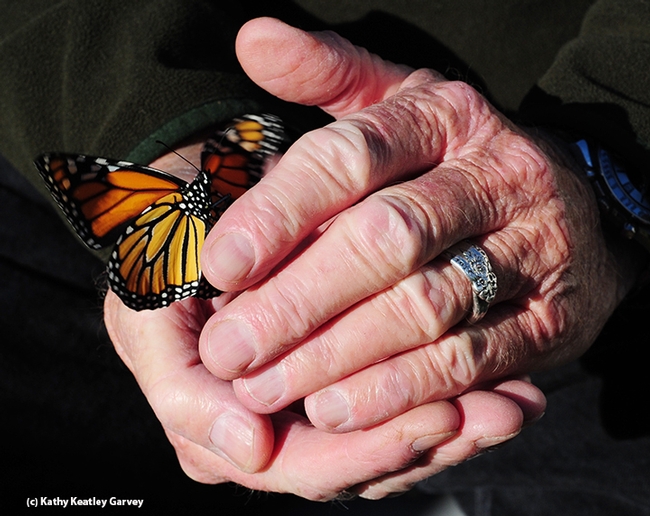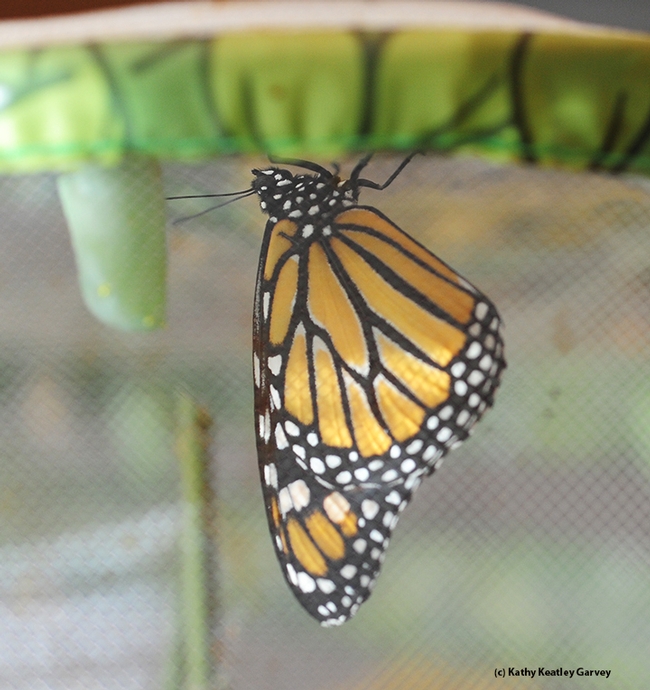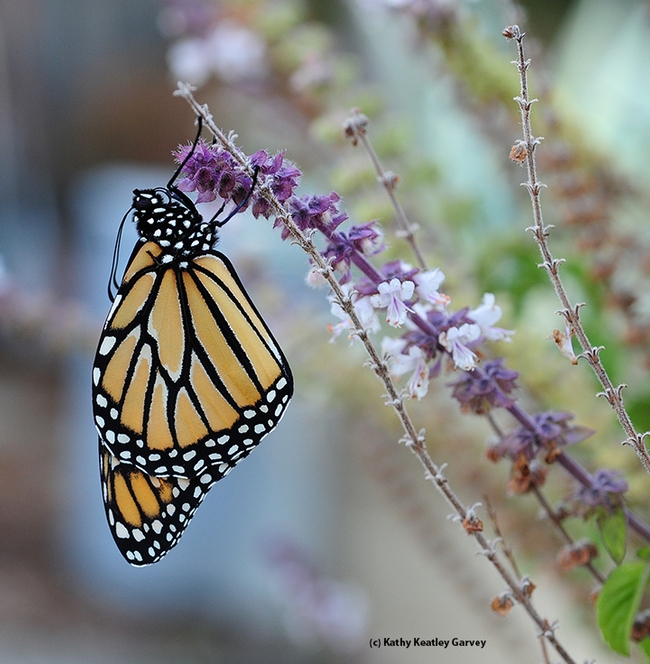- Author: Kathy Keatley Garvey
So here's this newly eclosed male monarch trying to sip a little nectar from a Mexican sunflower (Tithonia).
A female longhorned bee, probably Melissodes agilis, seeks to claim it. There's no such thing as sharing, especially when nectar is at stake and it's first-come, first-served. However, the monarch is well positioned. There's no room for both a butterfly and a bee. Not at the same time.
Then a male longhorned bee (probably Melissodes agilis) targets the monarch. Shoo, monarch! Outta here! I'm saving that flower for my girl!
If you look closely at the male bee/male monarch photo, you can see the monarch's wings don't seem quite right. They're not. Greg Kareofelas, associate at the Bohart Museum of Entomology, UC Davis, points out that "the wings are deformed; they did not fully expand and dry straight."
As for the longhorned bee, Melissodes agilis is one of more than 1600 species of undomesticated bees that populate California.
To learn more about bees in California, get a copy of the landmark California Bees and Blooms: A Guide for Gardeners and Naturalists (Heyday), the work of bee experts Gordon W. Frankie of UC Berkeley and Robbin W. Thorp of UC Davis, photographer/entomologist Rollin E. Coville, and UC Berkeley botany expert Barbara Ertter.
All have UC Berkeley connections. Thorp, distinguished emeritus professor of entomology at UC Davis, received his doctorate in entomology from UC Berkeley. Coville, who took the amazing, incredibly detailed photos for the book, also received his doctorate in entomology from UC Berkeley.
The book also includes information on 53 bee friendly plants--like Tithonia!--and how to grow them.
Tithonia, a member of the sunflower family Asteraceae, is a favorite of insects. Pull up a chair at a Tithonia patch near you and observe the diversity of foraging insects. Among them: honey bees, bumble bees, sweat bees, longhorned bees, and assorted butterflies, including monarchs, Western tiger swallowtails, Gulf Fritillaries, skippers, California buckeyes, mournful duskywings, painted ladies, and cabbage whites. And oh, some predators, too, including praying mantids and wasps (insects) and crab spiders and orb weavers (spiders).
There's never a dull moment in the Tithonia patch.

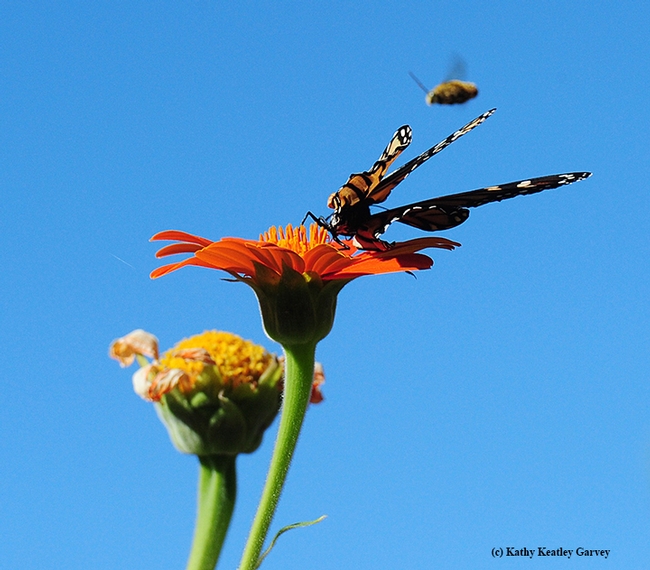
- Author: Kathy Keatley Garvey
For the last several months, we've seen monarchs laying eggs on our narrow-leafed milkweed.
A daily check yielded "zero" caterpillars. Zero. Nada. Zilch. One reason is apparent: two nearby nests of Western scrub jays filled with chirping babies. Birds aren't known for eating a large quantity of monarch caterpillars--they don't taste good--but they will still eat a few.
They didn't eat this one.
It was tucked away, hidden from sight. Then we found another caterpillar, also hidden.
In the interests of conservation--and to prevent predation--we placed them inside our indoor butterfly habitat, purchased last year from the gift shop at the Bohart Museum of Entomology, the University of California, Davis.
The rest, as they say, is history and herstory. A male eclosed from the first chrysalis, and a female from the second.
It's one of Nature's miracles. From an egg, to a caterpillar to a chrysalis to an adult Danaus plexippus.
One week, it's a hungry fifth-instar caterpillar...then it's a gold-dotted, jade-green chrysalis, a joy to see. When the chrysalis turns transparent, you can make out the colorful butterfly inside--Nature's gift that's soon to eclose.
From chrysalis to adult, the male took 10 days.
From chrysalis to adult, the female took 9 days.
We've already released the male. He soared high into the sky, at least 80 feet, and headed for an oak tree as a Western scrub jay eyed him. Whew! The predator did not pursue him.
The second monarch, the female, just eclosed this afternoon. It's Freedom Day tomorrow.





- Author: Kathy Keatley Garvey
So here's this hungry male monarch butterfly sipping nectar from a Mexican sunflower (Tithonia rotundifolia "Torch").
He's sipping, sipping, sipping. He's minding his own business. He's tending to his own needs. It's a good day in the pollinator garden.
Suddenly a bulletlike object dive-bombs his head. It returns and dive-bombs his wings. It returns again and dive-bombs his feet.
"Hey, this is my territory. I am claiming all of the Tithonia. I'm saving it for my ladies. Move!"
It's a male longhorned bee, Melissodes agilis. It's also known as an "agile longhorned bee." Agile? Because it is.
The territorial battle continues. Two boys, two different insect species, each trying to claim "The Torch."
Finally, the monarch lifts off and flutters over to another blossom.
"Hey, that's mine, too!"

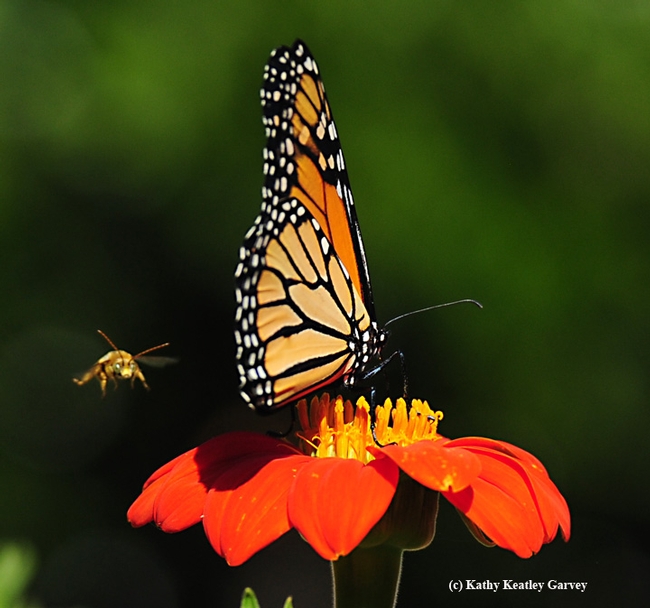
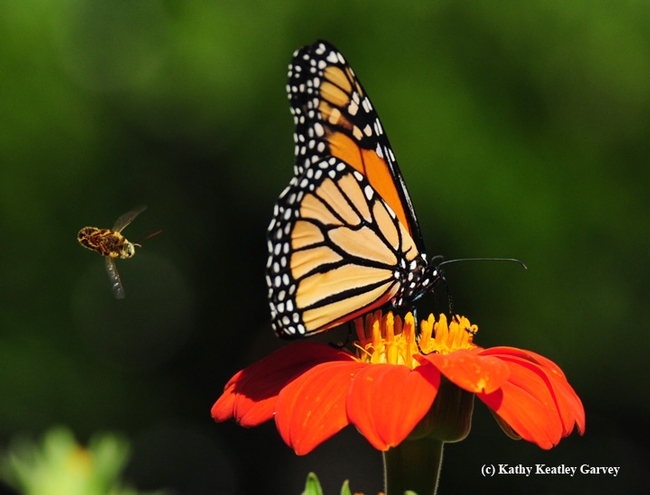
- Author: Kathy Keatley Garvey
Where have you been?
For the last several weeks, we've been watching for signs of the first seasonal monarch caterpillar on our narrow-leafed milkweed.
The lush leaves refused to yield any secrets. They looked untouched, undisturbed and intact. But on June 15, there it was, a not-so-little caterpillar munching away as if it had been there all along.
Where have you been?
How it managed to survive is puzzling. A Western scrub jay nest is about two feet away and we can hear the baby birds chirping throughout the day. Then the mother obligingly swoops down into the "supermarket" pollinator garden and grabs fresh food for them. We've seen her--and photographed her--plucking a Gulf Fritillary caterpillar from the passionflower vine. We've seen her perching on a flower pot and nailing bees. We've seen her flying back to her nest.
So, this not-so-little caterpillar, a sole survivor, overcame incredible odds. Butterfly guru Art Shapiro, distinguished professor of evolution and ecology at UC Davis, says that probably fewer than 10 percent make it from egg to adult. (And that's without a bird nest two feet away!)
In the interests of conservation, the monarch caterpillar is now safely housed in our butterfly habitat as we wait for it to form a chrysalis and emerge as an adult. Then we'll release it. It may soar 80 feet in the air, as others have done, or it may linger in the pollinator garden, or it may decline to fly away from our outstretched hand.
The parents will never meet the offspring, and the offspring will never meet its parents.
Nevertheless, Sunday, June 19 is Father's Day. Dad, you did good! And you, too, Mom!
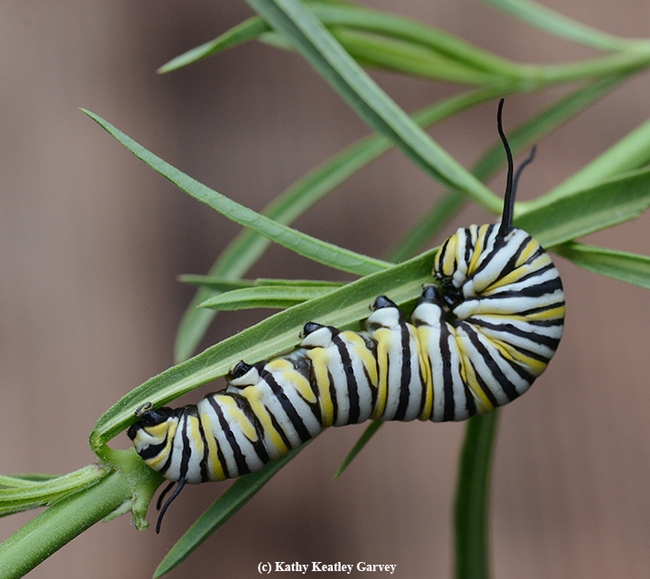

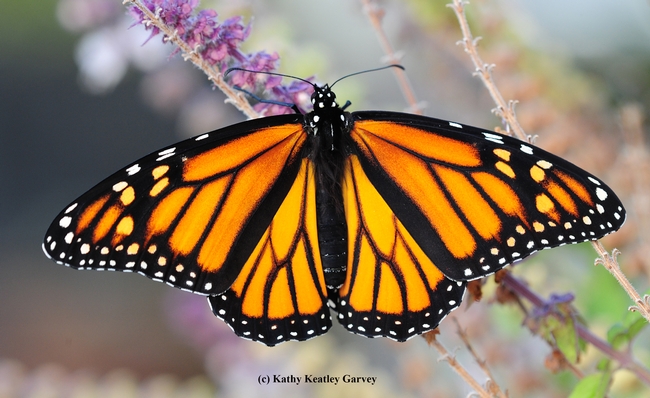
- Author: Kathy Keatley Garvey
A mid-life chrysalis?
Well, maybe not mid-life, but definitely out of season.
A female monarch butterfly eclosed today in our little indoor butterfly habitat. Two weeks ago, we “rescued” the caterpillar from a narrow-leafed milkweed plant in our Vacaville pollinator garden and brought it inside. Our goal: conservation. We sought to protect it from prey, including the resident scrub jays.
So, this morning, we lost a chrysalis and gained a butterfly. She was right on schedule: Eclosure after 10 days as a chrysalis.
When the temperature hit 61 degrees at around 1 p.m., we released her. She fluttered a bit, and then soared straight up, a good 80 feet high. Usually when we release the monarchs, they flutter around, sometimes touching down on a bush and sometimes soaring over it. This one wasted no time.
On its way to Santa Cruz?
Not sure. At 3:30 p.m., we spotted a monarch butterfly--same one?--roosting on our African blue basil as a dozen honey bees buzzed around, gathering nectar.
Meanwhile, the fellow members of her species are winging their way to their overwintering sites: the monarchs east of the Rockies to the Sierra Madre Mountains in Mexico, and those west of the Rockies to the California coast, including the Natural Bridges State Beach in Santa Cruz, and Pacific Grove in Monterey County. They cluster in eucalyptus, Monterey pines, and Monterey cypresses.
Monarchs do not fly at night. They travel only during the day and then find a roosting spot for the night. "Roost sites are important to the monarch migration," according to the U.S. Department of Agriculture's Forest Service. "Many of these locations are used year after year. Often pine, fir and cedar trees are chosen for roosting. These trees have thick canopies that moderate the temperature and humidity at the roost site. In the mornings, monarchs bask in the sunlight to warm themselves."
How many miles can monarchs travel a day? Between 50 to 100 miles, the Forest Service says. "It can take up to two months to complete their journey. The farthest ranging monarch butterfly recorded traveled 265 miles in one day."
Monarchs use a combination of directional aids, including the magnetic pull of the earth and the position of the sun. They take advantage of the air currents and thermals as they head toward their overwintering sights.
To think that we humans can barely make it out of the neighborhood without our GPS devices!
As of 5 p.m., the monarch roosting on the African blue basil is still there. The bees are gone, back to the warmth of their hives.
Tomorrow, our little buddy will warm her flight muscles, sip a little nectar, and take flight.
Safe travels, Miss Monarch!
